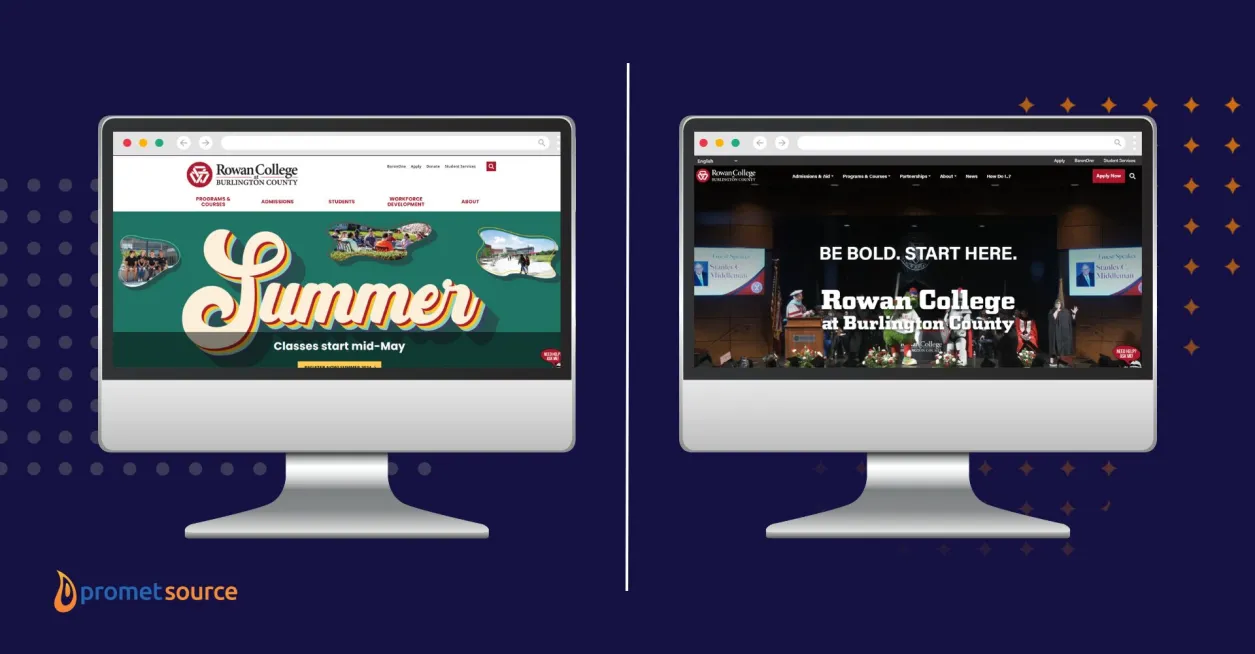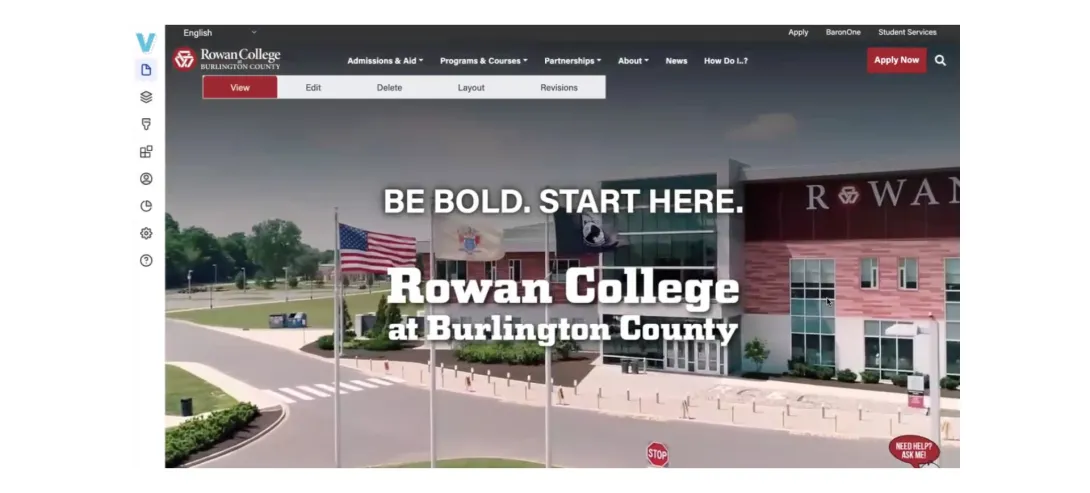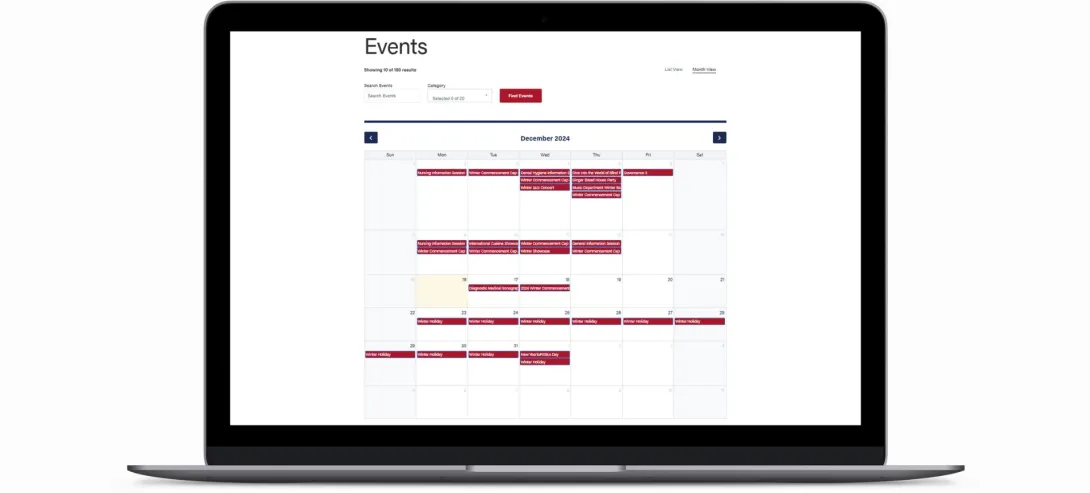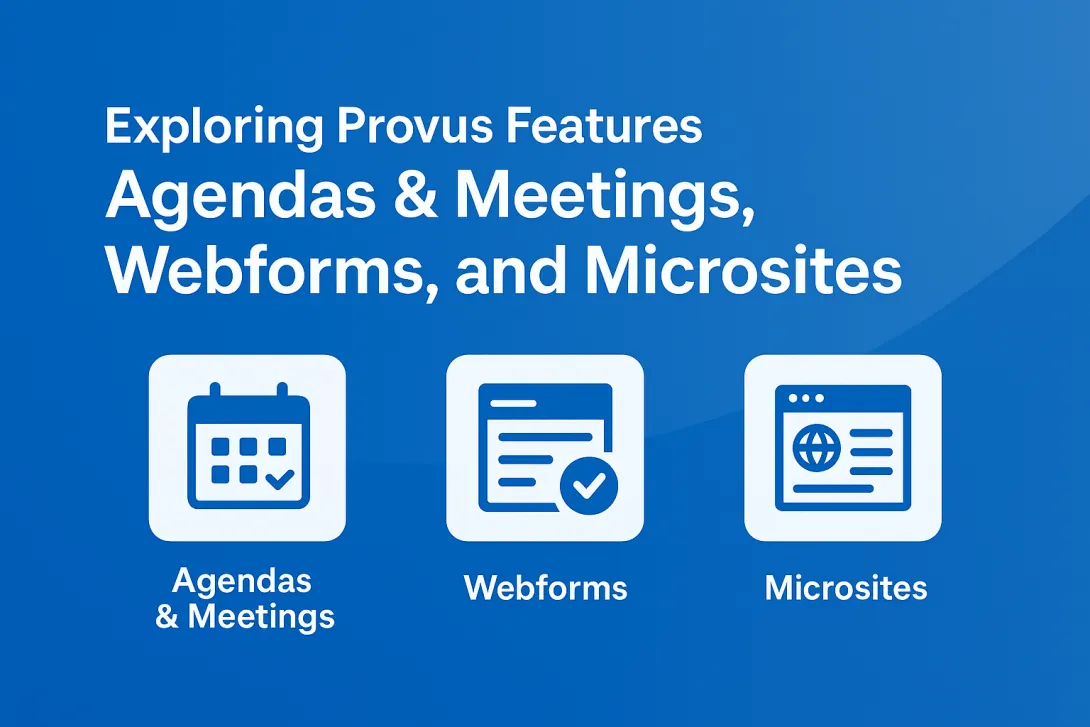Cut Your Website Redesign Timeline to One Semester

Table of Contents
Takeaway: Higher education institutions don't have to accept 9-18 month website redesigns as inevitable. With Provus®EDU and Pantheon, colleges and universities are launching modern, accessible, and fully functional websites in just one semester.

Picture this: It's the end of May, and your university's web communications director just got approval for that long-overdue website redesign.
The enrollment team is thrilled—finally, a modern site that won't sabotage recruitment efforts. IT breathes a sigh of relief knowing the archaic system will be replaced.
Everyone's excited until they hear the timeline: "We'll go live in 9 to 15 months, maybe 18 if we hit delays."
That excitement? It just died.
By the time your new site launches, you'll have missed two enrollment cycles. Your competitors will have captured prospects you lost to confusing navigation and broken application forms.
Your team's morale will be worn thin by months of committee meetings, vendor delays, and scope creep.
And that "cutting-edge" design you approved? It'll already look dated.
The traditional marathon redesign isn't just slow—it's expensive, exhausting, and increasingly unnecessary. Here's how forward-thinking higher ed institutions are breaking free from the old timeline and getting the websites they need when they actually need them.
GENERATE YOUR PROVUS®EDU DEMO SITE NOW
Ready to see what a four-month sprint looks like? Let’s start by tallying the hidden costs of the drag-it-out approach.
The cost of traditional website redesign timelines
Traditional higher ed website redesigns follow a predictable—and painful—pattern. What starts as an exciting digital transformation initiative slowly morphs into a multi-semester marathon that tests everyone's patience and drains resources that weren’t budgeted for.
Missed enrollment windows
The math is brutal. Start your redesign in May, and the best-case scenario has you launching the following February.
That means you've missed:
- Summer orientation sessions, where parents and students form first impressions
- The entire fall recruitment cycle, when prospective students are actively researching
- Early application deadlines when your conversion rates matter most
- Spring admitted student days when you need to close the deal
Meanwhile, your competitors with modern, mobile-friendly sites are capturing the students who gave up trying to find your nursing program requirements or figure out financial aid options on your current site.
Budget drain
That 12-month timeline isn't just 12 months of waiting—it's 12 months of costs piling up:
- Potential lost tuition revenue from frustrated applicants who went elsewhere
- Extended vendor contracts eating into next year's budget
- Staff time in endless stakeholder meetings and review cycles
- Missed opportunities to run effective digital marketing campaigns
- Band-aid fixes to keep the old site limping along
What started as a $200,000 project can easily balloon to $400,000 or more when you factor in these hidden costs.
Staff burnout
Perhaps the highest cost is the human one. Your web team starts energized but ends up exhausted from:
- Managing competing priorities from dozens of departments
- Explaining (again) why the timeline slipped another month
- Maintaining two sites—the dying current one and the future one in development
- Fielding complaints about the old site while unable to fix them
- Watching their innovative ideas get watered down through committee compromise
By month 10, your best people are updating their LinkedIn profiles.
Outdated technology by launch
The irony is that the modern website you approved won't be modern when it launches if you follow the common redesign timeline. During your 15-month redesign:
- Design trends have evolved
- Google has updated its algorithm at least twice (for reference, there were 7 confirmed updates in 2024)
- Students' device preferences could have shifted
- Your competitor launched features that weren’t even on the radar when your project kicked off
You've spent over a year building yesterday's website.
That’s why we compress the build to four months—so the tech is still fresh when you launch.
So, what does a one-semester schedule actually involve? Here’s the month-by-month playbook.
Academic-term turnaround: The 4-month promise
Here's a simplified breakdown of how your institution can achieve this timeline:

Month 1: Foundational tasks
- Kickoff Workshop: We have focused planning sessions to gather key stakeholders, develop a clear project scope, and define specific goals aligned with your institution’s enrollment priorities.
- Content Audit & Strategy: You audit existing content to identify what to migrate, archive, or rewrite, and determine the required navigation structure.
- Component Customization: We style Provus®EDU's components to match your institution’s unique brand and messaging.
Months 2–3: Agile development & iteration
- Rapid Site Assembly: We establish core pages and site infrastructure in weeks, not months, using Provus®EDU’s intuitive components.
- Content Migration & Authoring: A structured, role-based editorial workflow streamlines and accelerates content creation, migration, and approval processes—eliminating bottlenecks and reducing stress on your content team.
- Iterative Testing & Feedback Cycles: Rather than prolonged review periods, we have short iterative sprints, so your team can quickly provide feedback for updates and improvements. Content managers and subject experts stay closely engaged, reducing the risk of last-minute delays or misalignment.
Month 4: Final testing & website launch
- Quality Assurance, Accessibility, and Compliance Testing: Provus®EDU’s built-in WCAG 2.1 compliance ensures your institution meets accessibility standards without added complexity or unexpected delays.
- WebOps & Performance Optimization: Pantheon's platform provides automated deployment, rapid performance optimization, rigorous security testing, and scaling preparations so your new site meets peak traffic demand from day one.
- Launch & Ongoing Support: With confidence in all testing and QA complete, your new site launches seamlessly, just four months from project kickoff—ready to support the upcoming enrollment period.
Case in point: Rowan College at Burlington County

At Rowan College, Provus®EDU and Pantheon collaborated with administrators, faculty, and content owners to achieve a full, human-centered website redesign in just one semester.
- Rapid Implementation: Provus®EDU facilitated a swift implementation, enabling Rowan College to launch a fully functional, user-friendly website in just over four months.
- Empowered Content Editors: Provus®EDU enabled Rowan’s non-technical content editors to independently manage and update complex web pages without relying on IT support, significantly improving workflow efficiency.
- Enhanced Content Management: Content editors gained the capability to enable languages, configure content types, fields, and views directly, enhancing their autonomy and effectiveness.
- Custom Event Management: Rowan College used Provus®EDU’s flexible, filterable content views to create custom event listings by category without additional development effort, improving site organization and user experience.
With the Provus®EDU and Pantheon approach, higher education institutions no longer need to resign themselves to outdated timelines. Your website can be efficient, compliant, scalable—and delivered exactly when you need it.
The secret isn’t magic—it’s a library of higher-ed-ready building blocks that remove 80% of the usual lift.
Pre-built higher-ed component library
Think of Provus®EDU as a kit of LEGO® bricks engineered for higher-ed sites. Instead of starting from a blank page, you drag, drop, and launch pages that already solve the problems your team wrestles with every semester.
This is why we love component-based design.

What ships ready-to-use (and why it matters)
| Component | Immediate win for enrollment |
|---|---|
| Flexible page builder | Launch polished program pages in hours, not sprints—so prospects find compelling degree info before the next recruitment push. |
| Course catalog explorer | Filter by degree, modality, or interest area; turns “What can I study?” into a guided path straight to apply. |
| Events & academic calendars | Centralize open houses, application deadlines, and visit days; embed the same calendar anywhere to keep prospects in the loop. |
| Student portal integration | Give admitted and current students self-service access to schedules and resources, reducing phone calls at peak periods. |
| Digital forms hub | Spin up application add-ons, inquiry forms, and scholarship submissions without waiting on IT, accelerating lead capture. |
| FAQ knowledge base | Answer common admissions / financial-aid questions and cut response time for counselors. |
| Faculty & staff directory | Searchable profile pages build credibility for academic programs and boost SEO visibility. |
| Modern web builder blocks | Pre-styled hero banners, testimonials, and callout cards help marketing launch persuasive pages in minutes. |
| AI-powered site search | Semantic search surfaces the right page. Higher findability = fewer drop-offs. |
| AI chatbot (Civic AI Navigator-ready) | 24/7 answers on programs, deadlines, and campus life—captures late-night interest you’d otherwise miss. |
| Emergency alert banner | Keep your students safe with instant, WCAG-compliant notifications—critical during orientation and move-in weeks. |
| Filterable news & announcements | Highlight acceptances, rankings, and student success stories that nudge prospects toward “apply.” |
| Quick-links | Surface application, cost, and visit pages in one click, lowering abandonment in the decision phase. |
| Accessible out-of-the-box | Pre-tested WCAG 2.1 AA patterns mean every new page is compliant by default—no last-minute remediation. |
How the library cuts months off your timeline
- Zero from-scratch templates: 80% of your UI is pre-built and brand-ready on day one.
- Drag-and-drop authoring: Content teams assemble pages in hours, not sprints.
- Accessibility baked in: Every component ships WCAG 2.1 AA-compliant, eliminating late-stage remediation.
- Governance included: Role-based locks prevent accidentally changing content on the website while still empowering departments.
- Built for scale: Add new microsites (honors college, research center) by cloning a proven component set—no new RFP.
I'm beyond proud of my team today - especially our website lead Jay Varga - for launching the new rcbc.edu today. We spent the summer reviewing 1,700 pages but really had four weeks to manually carry over 1,000 pages to the new site. Thanks to Aaron, Lori and Amy at Promet Source for helping us get this off the ground.
—Greg Volpe, Executive Director of Strategic Marketing and Communications at Rowan College at Burlington County
Update: Website Performance and Outcomes
Website Goal: Consistently provide accessible, easy-to-find information with user-friendly language for future and current students, community members, and staff.
The college’s website serves as its primary communications tool. It’s always on and available to serve students, prospective students, and the community whenever they need information. Each year, the site attracts 700,000 users, with 88% being new visitors, according to Google Analytics.
A review of the first year since the substantial redesign of the college’s website shows that the college’s investment in time, talent, and resources has delivered measurable results and improved the overall user experience.
| Total Users | New Users | Engaged Sessions per Active User | |
|---|---|---|---|
| Results | 643,035 | 562,072 | 1.67 |
| Change | 9.0% increase | 0.4% increase | 6.3% increase |
After the initial website build and launch, the focus has shifted to refining language on academic pages. Although this work continues, these web pages have experienced significant growth in traffic, while engagement time per session and the number of new users have decreased. Nearly 90% of this traffic is driven by Health Sciences majors, suggesting that many visitors are applicants or enrolled students reviewing program requirements. The reduction in engagement time is likely due to a strategic decision to host curriculum information within the college catalog, which is seamlessly linked from each program page but housed on a separate subdomain that is not captured in Google Analytics.
| Sessions | Users | New Users | Average Engagement Time Per User | Events | |
|---|---|---|---|---|---|
| Results | 100,224 | 45,490 | 23,218 | 1:04 | 3,591 |
| Change | 71.8% increase | 13.9% increase | 27.6% decrease | 30.4% decrease | 41.5% increase |
With the heavy lifting already done, your team spends its energy on messaging and conversion paths, not rebuilding the wheel.
Of course, speed dies if publishing grinds to a halt the day after launch, so let’s talk governance.
Governance without bottlenecks
A 4-month launch only works if publishing stays fast after go-live.
Provus ®EDU builds in structured governance that continuously empowers your teams to publish quickly and autonomously. Learn more about how our higher ed Drupal distribution keeps your brand safe and your content fresh.
Role-based permissions, minus the ticket queue
| Sample role | What they can do | Why it matters |
|---|---|---|
| Student workers | Update copy, swap images, publish to pre-approved sections | No more “please change this comma” IT tickets. |
| Content staff | Create landing pages from branded templates, request URL aliases | Decentralizes workload while preserving consistency. |
| Department head | Final OK on high-visibility pages, push to production | Protects brand voice and ADA compliance. |
| IT / WebOps | Manage integrations, security updates, and global settings | Keeps technical risk under one roof without blocking content. |
Workflow that mirrors higher-ed reality
- Draft: Editors see real-time previews (Layout Builder) so there’s no back-and-forth on layout.
- Department review: Optional step for deans or chairs—they get a one-click “approve / request change” notification.
- Brand & accessibility check: Automated WCAG scanner flags issues before your marketing team reviews.
- Publish: Pantheon’s WebOps pipeline pushes to prod in seconds—no downtime during peak traffic.
Built-in safeguards
- Component-level locks ensure color palette and typography stay on brand—even when dozens of editors are building pages.
- Reusable snippets for tuition disclaimers, FERPA language, and privacy notices keep legal text consistent site-wide.
- Audit trail & versioning let you roll back a page or track who changed what (a lifesaver during accreditation reviews).
Provus® EDU is 100% open-source Drupal. Your team owns the code and the roadmap, so you can switch agencies, add new partners, or extend the platform without paying proprietary license fees or waiting for a vendor queue.
In other words: All the guardrails you need, none of the handcuffs you hate.
And because those guardrails play nicely with the rest of your campus tech, integrations stay painless.
Plays nicely with your campus stack
Provus ®EDU integrates easily with your existing tech, so connecting to your student portal, LMS, and other campus stack is done with configuration, not custom code.
That means data-driven widgets (course catalogs, application status, faculty bios) can live in Drupal while the source of truth stays in your institutional systems.
With governance friction removed, your marketing and enrollment teams can iterate as fast as their campaigns—without ever waiting on IT.
Fast content is meaningless if an accessibility audit blocks go-live—so compliance comes next.
Accessible by default
Fast is worthless if you fail an accessibility audit the week before launch. Provus® EDU ships with compliance patterns baked in, so you hit the 4-month deadline without a late-stage remediation scramble.
WCAG 2.1 on autopilot

- Pre-tested components: Every block meets WCAG 2.1 AA for color contrast, keyboard focus, and ARIA roles.
- Alt-text enforcement: Image uploads require descriptive text; no more empty alt tags slipping through.
- Semantic heading locks: Prevents the classic “bold H3 to look big” error that confuses screen readers.
Speed without fragility
Because compliance is coded into the design system, adding a new page at 2 a.m. for a surprise deadline still passes automated scans. Your team moves quickly and stays within the rules—no extra QA line item eating the clock.
None of this matters if the server can’t keep up, which is why the stack runs on Pantheon’s WebOps engine.
Pantheon WebOps advantage

Launching your website within one semester demands a robust infrastructure that never slows your team down. Pantheon WebOps is the powerhouse infrastructure that enables Provus®EDU to deliver rapid, reliable results.
Why WebOps matters for rapid launches
| Pantheon feature | Impact on a 4-month timeline |
|---|---|
| One-click multidev sites | Instantly create dedicated review environments, significantly shortening stakeholder approvals and accelerating content go-live. |
| Automated testing & backups | Automated tests with each deployment mean fewer manual reviews, faster IT approvals, and zero sleepless nights worrying about stability. |
| Edge-caching & CDN | Lightning-fast site performance ensures peak responsiveness even during critical enrollment surges. |
| Managed HTTPS, auto-updates | Automatic security updates eliminate unexpected pre-launch freezes, ensuring a smooth, secure, and timely go-live. |
Automated hosting and security continuously empower your IT team to focus strategically on key integrations, ensuring stable operations and enabling marketing teams to quickly deliver impactful content independently.
All that’s left is to see it in action—and beat the next enrollment deadline.
Next steps: See how fast you can launch
Ready to test-drive the four-month roadmap on your campus site?
Generate your Provus ®EDU demo in as fast as 15 minutes. You’ll get a live sandbox, full component library, and Pantheon back-end—for 10 business days.
Stop planning around 18-month projects. Start enrolling with a modern, accessible site next semester.

Get our newsletter
Get weekly Drupal and AI technology advancement news, pro tips, ideas, insights, and more.




